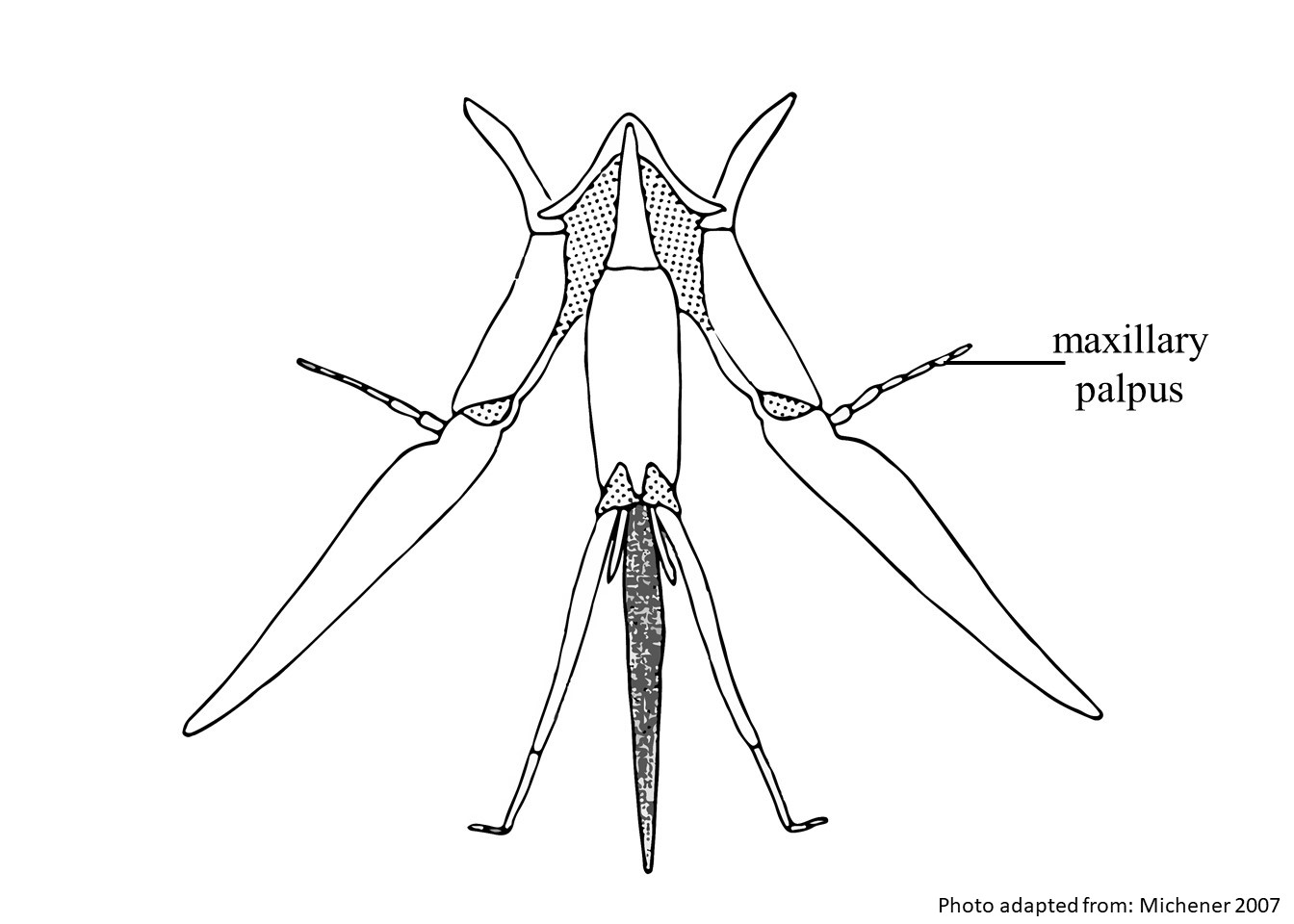Family: Megachilidae
Subfamily: Megachilinae
Tribe: Osmiini
Genus: Osmia Panzer, 1806
Subgenus: Erythrosmia Schmiedeknecht, 1885
Common name: none
Osmia (Erythrosmia) are non-metallic bees that sometimes have red abdomens. The pubescencepubescence:
short, fine hair
is pale and sometimes red (Michener 2007Michener 2007:
Michener, C.D. 2007. The Bees of the World (2nd ed.). Johns Hopkins University Press, Baltimore and London, 953 pp.). They range in body length from 5.5–10 mm (Michener 2007Michener 2007:
Michener, C.D. 2007. The Bees of the World (2nd ed.). Johns Hopkins University Press, Baltimore and London, 953 pp.).
(modified from Michener 2007Michener 2007:
Michener, C.D. 2007. The Bees of the World (2nd ed.). Johns Hopkins University Press, Baltimore and London, 953 pp.)
 has four segments and a minute apicalapical:
has four segments and a minute apicalapical: .
. sometimes without laterallateral:
sometimes without laterallateral: is elongate and has a median apicalapical:
is elongate and has a median apicalapical: bifidbifid:
bifidbifid:Osmia (Erythrosmia) may be confused with O. (Allosmia) due to a similar slender body shape, but can be differentiated by the differences in the number of segments on the maxillary palpusmaxillary palpus:
one of the pair of jointed, sensory structures carried on the maxilla of the mouth parts
 . Osmia (Erythrosmia) has four segments and sometimes a minute apicalapical:
. Osmia (Erythrosmia) has four segments and sometimes a minute apicalapical:
near or at the apex or end of any structure
fifth segment, while O. (Allosmia) has five segments (Michener 2007Michener 2007:
Michener, C.D. 2007. The Bees of the World (2nd ed.). Johns Hopkins University Press, Baltimore and London, 953 pp.).
Osmia (Erythrosmia) are generalists and have been observed visiting Lamiaceae, Fabaceae, Boraginaceae, Crassulaceae, Brassicaceae, Cistaceae, Antirrhineae, and Campanulaceae (Müller et al. 1997; Müller 2018).
Osmia (Erythrosmia) have been observed nesting in snail shells where they use masticated leaves and broken snail shell pieces as building materials (Michener 2007Michener 2007:
Michener, C.D. 2007. The Bees of the World (2nd ed.). Johns Hopkins University Press, Baltimore and London, 953 pp.). Osmia (Erythrosmia) andrenoides nest in small to medium-sized snail shells hidden under stones. Nests are comprised of one cell, which is partitioned with leaf pulp from Helianthemum. Cell walls are built from leaf pulp mixed with pebbles. Small pebbles and small sticks from plants are used to fill the space between the cell partition and the nest plug (Westrich 1989Westrich 1989:
Westrich, P. 1989. Die Wildbienen Baden-Wuuml;rttembergs. Eugen Ulmer GmbH amp; Co., Stuttgart, 972 pp.; Banaszak and Romasenko 2001Banaszak and Romasenko 2001:
Banaszak J. and L. Romasenko. 2001. Megachilid bees of Europe. Second edition. Bydgoszcz: Bydgoszcz University Press. 239 pp.; Müller 2018).
Osmia (Erythrosmia) contains four species (Müller 2018). None are known to occur in the U.S. or Canada.
There are no known invasives.
Osmia (Erythrosmia) can be found in Europe, southwestern Asia, the Mediterranean Basin, and East to Central Asia (Michener 2007Michener 2007:
Michener, C.D. 2007. The Bees of the World (2nd ed.). Johns Hopkins University Press, Baltimore and London, 953 pp.).

Distribution map generated by Discover Life -- click on map for details, credits, and terms of use.
Banaszak J. and L. Romasenko. 2001. Megachilid bees of Europe. Second edition. Bydgoszcz: Bydgoszcz University Press. 239 pp.
Michener, C.D. 2007. The Bees of the World. 2nd ed. Johns Hopkins University Press, Baltimore and London, 953 pp.
Müller, A., A. Krebs, and F. Amiet. 1997. Bienen: Mitteleuropäische Gattungen, Lebensweise, Beobachtung. Naturbuch Verlag, Augsburg, pp. 384.
Müller, A. 2018. Palaearctic Osmiine Bees, ETH Zürich, http://blogs.ethz.ch/osmiini
Westrich, P. 1989. Die Wildbienen Baden-Württembergs. Eugen Ulmer GmbH & Co., Stuttgart